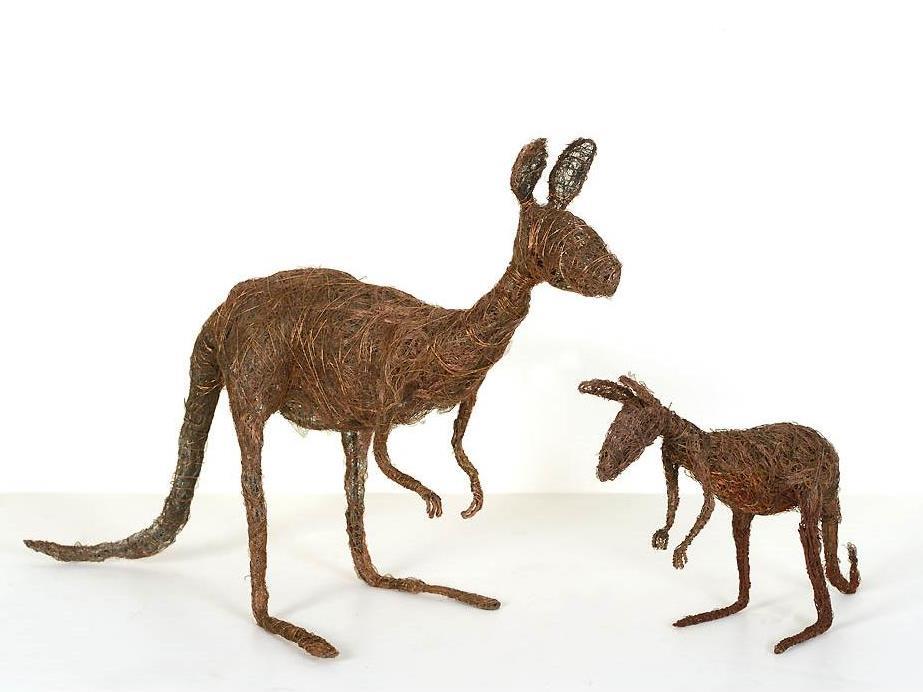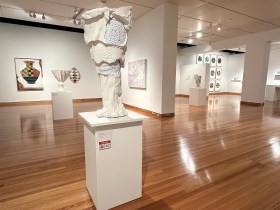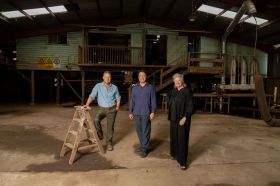Desert Mob, Johnny Young, Untitled, TAP 01
Australia’s Indigenous art centres are far more than simply places to paint. An art centre works beyond the four walls of the building. It’s a vehicle for artistic expression and forms a core community sharing culture and stories.
Aboriginal and Torres Strait Islander art centres are a vital part of community life in remote Australia, across Central Australia, SA, WA, Anangu Pitjantjatjara Yankunytjatjara Lands (APY Lands), the NT and Far North Queensland.
Art centres across Australia often act as the first artistic outlet for Indigenous Australians because of this they are increasingly the birthplace for emerging trends and art forms.
Stephen Williamson, responsible for curating the installation of the Aboriginal art exhibition Desert Mob – featuring collections from over 30 art centres – said the work coming out of art centres sets trends for the artistic landscape.
‘In the early years of Desert Mob, there was a lot of craft works in the exhibition which was reflective of what was happening with Indigenous art from Central Australia at that time, craft works were a big component of the art being produced, in some cases even more so than paintings,’ said Williamson.
‘The Desert Art movement evolved and paintings became so much more prominent and sought after by the market and Desert Mob has allowed those works to be exhibited. It’s the place to see the current trends that are happening and the shifts and innovations that have taken place.’
The Desert Mob exhibitions are often ahead of the industry and breaking new ground. ‘Desert Mob has been a testing ground for art centres to launch new innovations in the art works being produced. That’s always been one of its features, come in and see what’s happening and who is really pushing the envelope in terms of what they’re doing,’ said Williamson.
The inaugural TARNANTHI festival showcases the work of artists and art centres from across Australia. Artistic Director Nici Cumpston said the festival is about providing an opportunity for artists to be able to tell their story from their own perspective.
‘There aren’t many opportunities for Aboriginal and Torres Strait Islander artists to be showcased. There are events around the country but this is the first time that the art gallery itself has done anything this ambitious. It’s really important to have this opportunity and to provide the support that the artists need to make new work for events like this. I can’t emphasise [enough] how important it is for these opportunities to happen and for the artists to be able to have their voices heard,’ said Cumpston.
Ananguku Arts & Culture Aboriginal Corporation will be running a stall at the art fair at the TARNANTHI festival, representing eight art centres across South Australia and the APY Lands. General Manager at Ananguku Arts Elizabeth Tregenza emphasised the importance of art centres to enable artists who are not represented by galleries to put their work to market.
‘An art fair adds a bit of extra oomph. It’s a very exciting time, to bring artists together to share the experience, to show their work. It’s also a great educative tool for the public,’ she said.
Educating the wider community about Indigenous culture and art practices is something the Wilin Centre at Melbourne University seeks to achieve through the Victorian College of the Arts and the Melbourne Conservatorium of Music. Head of Curriculum and Programs at the Wilin Centre, Richard Frankland, said that more work needs to be geared towards educating both Indigenous and non-Indigenous people through the arts.
‘It’s vital, not just for the students and not just for Aboriginal people, but it’s vital for the cultural tapestry of Australia, to enable people to have an access point to welcome the power of education. This is crucial for all races,’ said Frankland.
Individual art centres often have a distinct style and nuance to their art.
Manager at Ikuntji Artists Dr Chrischona Schmidt said it was important to be aware of the variation in the work produced by art centres across Australia, which was influenced by landscape and the ancestral stories of individual communities.
‘Most people in Australia don’t know the difference between different art centres, and they don’t know what the difference is between an art centre and a private dealer,’ said Schmidt.
Ikuntji Artists located within the West MacDonnell Ranges in NT is particularly famous for the use of bold and vibrant colours and for creating abstract paintings. Their work is distinctive for inspiration from their personal Ngurra (country) and Tjukurrpa (dreaming).
Desert Mob’s South Australian art centres have foundations in the desert art movement with a renewed contemporary focus.
Ananguku Arts also has a desert origin and a strong foundation in APY Lands cultural practice.
The Martu people of Western Desert use both traditional and modern media producing a range or work that can be explored through the We don’t need a map exhibition, supported by Fremantle Art Gallery.
In Far North Queensland, art centres connected through the Indigenous Art Centre Alliance (IACA) show influence from their rainforest and coastal surroundings with strong tropical colours. The area also incorporates the ghost net art unique to the Erub Erwer Meta of the Darnley Island Art Centre.
Manager of Indigenous Art Centre Alliance Pamela Bigelow said that while Indigneous art centres are still grounded in traditional roots they also use contemporary media.
‘A lot of art centres still produce traditional work but many are using contemporary materials to translate and communicate traditional stories through different mediums. We have materials used right across the spectrum, a lot of ceramics, ghost nets, print, painting, a lot of variety in wood carvings. The art centres are finding their own special and unique offerings and artistic presentation.’
Participating institutions:





